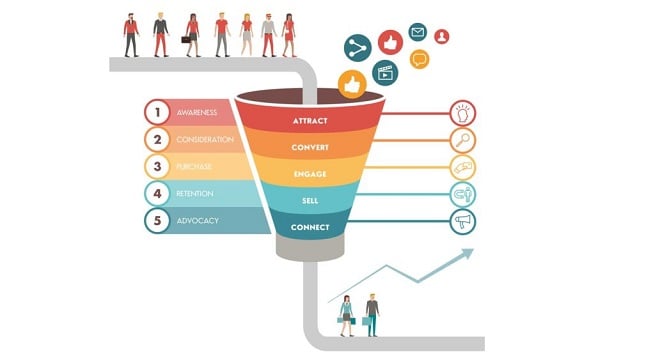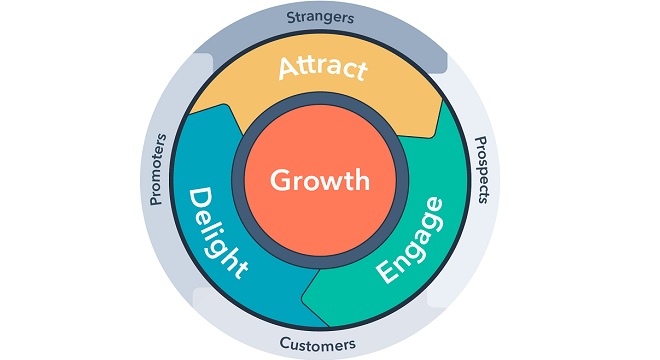Services List
Between funnels and flywheels, the world of marketing seems quite strange. And though we'd be the first to admit that this wonderful world is quite bizarre, it's a fun space to learn, grow and work in. But let's take a look at the differences between those two schools of thought: funnels and flywheels.

For years, companies have structured their business strategies around the marketing funnel — and it worked. But the funnel failed marketers, salespeople, and business leaders alike. Today, customer referrals and word-of-mouth have become the largest influence on the purchase process, which means the funnel has one major flaw: It views customers as an afterthought, not a driving force. You see, funnels produce customers but don’t consider how those customers can help you grow. That’s why the flywheel is so important.
The actions taken by each team at your company impact each other. Your marketing inputs affect how quickly prospects move through your sales process. Your sales motion affects how likely it is prospects will become happy and successful customers. And, of course, your support and service activities impact whether your customers become promoters — people who recommend you to their colleagues — or warn their networks to stay away.
What Is A Marketing Flywheel?
The traditional funnel doesn’t account for any of these factors. And because they’re linear, funnels don’t reveal the momentum you build through a great product and customer experience, nor the drag you experience when your processes start to slow down growth.
The Marketing Funnel
The funnel is as classic as a tool can get in marketing. This ubiquitous analogy represents the stages a prospective customer goes through on their buyer journey. The stages are usually broken down into:
- Awareness
- Consideration
- Conversion
Some add loyalty and advocacy at the bottom of this funnel. Others add a note like “rinse and repeat.” The funnel is helpful in visualizing the customer journey in specific steps. Within each stage, the company can assign specific actions. The awareness stage may contain actions like leads visiting the website, filling out a form, watching tutorial videos or reading the blog. In the next stage, they might take a stab at a free trial. After their trial, they might become paying customers.

The Marketing Flywheel
Much like an engine needs a flywheel to store energy, marketers need a marketing flywheel to garner the power of loyal customers. The flywheel is similar to the funnel in that it represents the customer journey in three main stages. HubSpot coins the flywheel stages as:
- Attract
- Engage
- Delight
At the center of the wheel is the customer base. The rotation of the wheel is the growth of your business. Happy customers are the energy that fuel the growth. n a flywheel, growth and customers are the center of every other process. Everything literally revolves around customer experience. Loyal customers are the energy that fuels all growth. Customers never fall out of the loop. They are not lost energy.

So, What Is The Difference Between The Marketing Flywheel And The Marketing Funnel?
It is seen that the marketing funnel template is more focused on acquiring one-time buyers. It can also be termed as a user acquisition funnel. This can be easily observed through its structuring, where the top of the funnel is kept heavy and all the effort and energy is invested in searching for new customers, instead of repeat buyers.
Flywheels look forward to customer delight and repeats purchases from existing customers. It is long-sighted and curvy.
Marketing Flywheel leverages you to use client marketing tactics like in-person events, client newsletter, and exclusive customers’ content, ways to nurture your leads in the long run. Engagement keeps your customers coming back for new products and services from you. This, in turn, increases the momentum of your flywheel and your customer base.
The purchasing power and lots of choices have made your customers better marketers than you. HubSpot says word-of-mouth is the greatest referrals. How long do you bring new customers?
You should look forward to building meaningful relationships with your customers and put those customers at the center of the organization, Sales flywheel does. Don’t ignore your customers, take your client-merchant relationship to the next level by fostering it through positive partnership. It will serve your business powerful recommendation, that actually works!
The flywheel is relationship-focused. Not only, but it also spins your wheel faster and keeps it spinning. The flywheel grows stronger as your customers grow, your wheel spins faster, fueling your growth along with your customers.
Whereas in flywheel case maximum weight is given to delight customers – the final stage of inbound. Delivering exceptional customer service to your customers enhances the spinning speed, reduces friction, and accelerates your business growth with happy customers.
How Do I Use A Marketing Flywheel?
Need For Speed
The speed of the flywheel increases, when the force is applied to those areas where it could have a larger impact increases.
In the marketing funnel model, all the force was applied to attract prospects and convert them. While in the flywheel system, more force is applied to delight those customers by making their purchase more satisfying and repeating them.
The Truth About Friction
When there is a lack of alignment between sales and customer success, it slows down your wheel. In easy words, when you have a trail of unhappy customers, it adds friction to your spin.
To reduce that friction you need to look through the inefficiencies and the point where your customers are losing momentum. Turn up to improve conversion rates, customers delight, and addressing customer experience to increase the speed of your flywheel at scale.
Focus And Weight
Focus on increasing speed and decreasing friction. When you have delighted customers the Flywheel grows heavier in weight. It produces more energy when turned at a high speed. As customer count increases, your flywheel produces more growth.


-Jan-22-2024-10-54-13-6898-AM.png?width=1200&name=CRM%20System%20(1)-Jan-22-2024-10-54-13-6898-AM.png)

